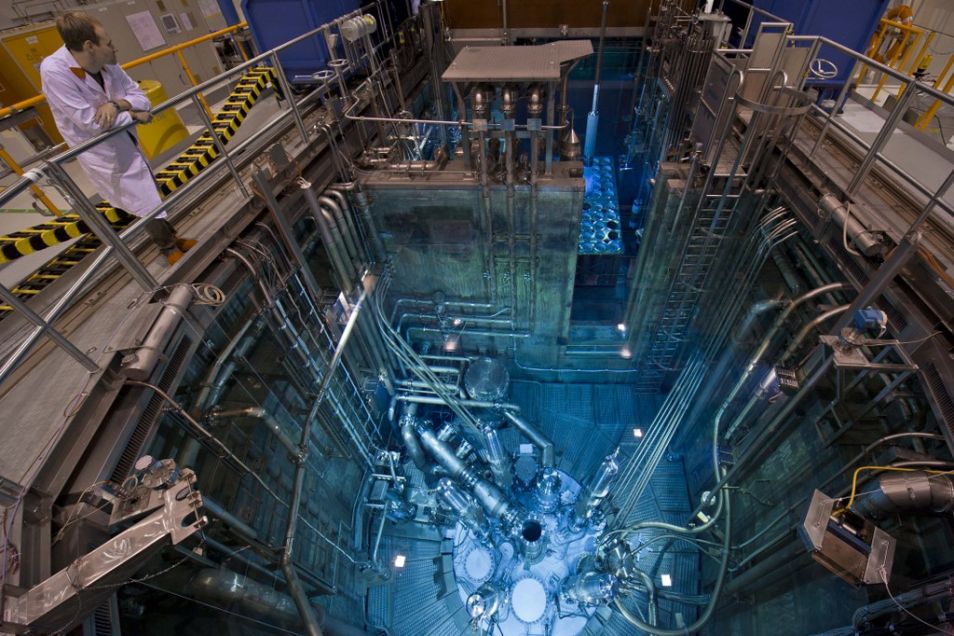MLZ is a cooperation between:
 > Technische Universität München
> Technische Universität München > Helmholtz-Zentrum Hereon
> Helmholtz-Zentrum Hereon
 > Forschungszentrum Jülich
> Forschungszentrum Jülich
MLZ is a member of:
 > LENS
> LENS > ERF-AISBL
> ERF-AISBL
MLZ on social media:

MLZ (eng)
Lichtenbergstr.1
85748 Garching
Neutron Source
In nature, neutrons appear only as bound particles in atoms. Consequently, free neutrons for applications in research, industry or medicine need to be produced by nuclear reactions. High intensity neutron beams for scattering experiments are generated in fission reactors or spallation sources.
Neutrons produced by nuclear fission
Neutron sources, such as the research neutron source Heinz-Maier Leibnitz, produce neutrons by nuclear fission. For that purpose a low energy, so-called thermal neutron is captured by a fissile heavy isotope, such as Uranium-235. The uranium isotope splits typically into two lighter elements, 2-3 fast (high energy) neutrons, and various light elementary particles. This process is accompanied by the release of energy. One neutron per fission, slowed-down in the heavy water (D2O) moderator tank and scattered back into the fuel element by the surrounding moderator, is necessary to maintain the self-sustaining chain reaction. About 1-2 neutrons are available for scientific use.
The FRM II is the most powerful neutron source in Germany. Relative to its thermal power (20 MW), it is capable of producing the highest neutron flux (8 × 1014 neutrons cm-2s-1) in the world. Besides FRM II, other main high-flux research neutron sources include the Institute Laue-Langevin (ILL) source in Grenoble, France, the Oak Ridge National Laboratory (ORNL) in the US, the high flux reactor (HFR) in Petten, in the Netherlands or BR2 in Mol, Belgium. Further neutron sources operated in Germany include the research reactor BER II at the Helmholtz-Zentrum Berlin and the research reactor FRMZ in Mainz. All of the above research neutron sources are optimized for special applications such as beam tube experiments for basic research, isotope production or fuel development.
Neutrons of different energies
In order to ensure that the energy, or in other words, the wavelengths of neutrons, are suited to particular experimental needs, so-called “secondary sources” are used as spectrum-shifters. Hot sources (graphite, about 2200 K) or cold sources (liquid hydrogen or deuterium as used at FRM II, about 20 K) modify the energy spectrum of the released neutrons for different applications. The different energy ranges (wavelengths) of neutrons are roughly classified according to the moderator temperature as hot, thermal, cold, and ultra-cold.
Neutrons produced by spallation
A spallation source produces pulsed or quasi-continuous neutron beams by the acceleration of protons hitting the target material of heavy nuclei, such as mercury, tantalum, or lead. In contrast to the fission of heavy nuclides, one spallation reaction, however, releases about 20 – 30 neutrons per incident particle. The British ISIS neutron source, the U.S. Spallation Neutron Source SNS, the Japanese research complex J-PARC and the Swiss spallation neutron sources SINQ are among the most powerful spallation devices worldwide. The planned European Spallation Source (ESS), to be built in Lund, Sweden, is expected to rank among the world’s leading neutron research facilities.
MLZ is a cooperation between:
 > Technische Universität München
> Technische Universität München > Helmholtz-Zentrum Hereon
> Helmholtz-Zentrum Hereon
 > Forschungszentrum Jülich
> Forschungszentrum Jülich
MLZ is a member of:
 > LENS
> LENS > ERF-AISBL
> ERF-AISBL
MLZ on social media:







